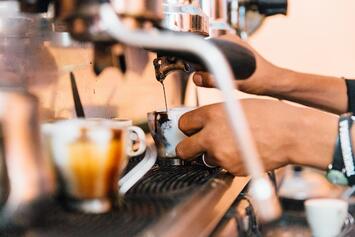
Have you ever noticed that there’s nothing more generic than a “local” coffee shop? As Orianna Schwindt wrote for New York magazine about the unbearable sameness of cities:
I was in a non-chain coffee shop in Columbia, South Carolina. I was on a mission to the cities and towns closest to the geographic center of each state, and this was only stop No. 6 of 50, but I remembered seeing the same lights in coffee shops in Bend and Portland in Oregon, and innumerable others I had frequented while living in New York and the Chicago area.
This one small observation opened up the floodgates. I noticed the same kind of person was behind the counter: young and tattooed and bespectacled. The same kind of patrons: young and tattooed and bespectacled, clacking away on MacBooks. The WiFi passwords were all some cutesy variation on “coffee culture”: !Java!, TheGreatBambeano, that sort of thing. I couldn’t stop noticing. I’d go on to see the same in Colorado Springs, in Fresno, in Indianapolis, in Oklahoma City, in Nashville.
And it wasn’t just the coffee shops — bars, restaurants, even the architecture of all the new housing going up in these cities looked and felt eerily familiar.
Despite the obsession with “local” today, it seems every city is trying its hardest to make itself as generically hipster as humanly possible.
This is also how they sell themselves. Every city marketing video is basically the same. This is an older one from Lincoln, Nebraska that is a particularly clear version of this.
Frankly all of them are some variation on this same theme. The newer ones are only different in that they now tend to show two to three times as much diversity as actually exists in these places. They are almost all extremely cringe.
Why is this? Why can’t cities actually emphasize their uniqueness? Why is that that while they boast about how unique they are, their presentation is invariably generic?
I’ve had a number of theories over the year. One is a sense of shame and lack of self-confidence, that is, cultural cringe. Another one is the effect where those who are on the outside hoping to get into the cool kids club always try harder to do what the cool kids are doing. Still another is that locals have a lot of emotional associations with scenes of their own city, and so can’t appreciate how an outsider lacking any personal connection will view it.
These probably all play a role. But Benjamin Mabry’s essay on managerial aesthetics opens another window on to this.
The aesthetics of the local coffee shop or microbrewery, ones are so standard issue that they might as well be a franchise, are managerial aesthetics. It is “local” detached from any genuinely local self-presentation and co-opted into just another cosmopolitan brand.
Read the rest of this piece on Aaron Renn Substack.
Aaron M. Renn is an opinion-leading urban analyst, consultant, speaker and writer on a mission to help America's cities and people thrive and find real success in the 21st century. He focuses on urban, economic development and infrastructure policy in the greater American Midwest. He also regularly contributes to and is cited by national and global media outlets, and his work has appeared in many publications, including the The Guardian, The New York Times and The Washington Post.
Photo: Kelly via Pexels.












